Welcome to our comprehensive guide on how to stop African Grey biting and tame your beloved parrot. African Grey parrots are intelligent and beautiful birds, but biting behavior can be a challenge for bird owners. If you are struggling with your African Grey’s biting habits, you’ve come to the right place. In this article, we will explore the reasons behind biting behavior, effective training techniques, and how to create a safe and enriching environment for your feathered friend.
African grey parrots are highly intelligent birds that often bite their owners. Effective training techniques like positive reinforcement can help stop an African grey from biting and build trust between the bird and its owner.
Causes of Biting in Parrots
Parrots have their own unique ways of communicating, and sometimes, biting can be one of them. Understanding why parrots bite is crucial for preventing this behavior and fostering a harmonious relationship with your feathered friend. Biting in parrots can have various causes, including:
Fear and Self-defense
Parrots may bite out of fear or as a means of self-defense. When they feel threatened or insecure, their natural response can be to bite. Understanding your parrot’s body language cues, such as fluffed-up feathers, dilated pupils, or a raised crest, can help you anticipate their fear and take steps to alleviate it.
Over-bonding and Territory
Parrots are intelligent creatures that can form strong bonds with their human companions. However, over-bonding can sometimes lead to possessive and territorial behavior, which may result in biting. It is important to establish boundaries and provide your parrot with a sense of security while also respecting their space.
Stress and Frustration
Just like humans, parrots can experience stress and frustration. These emotions can arise from various factors, such as lack of mental stimulation, changes in their environment, or a disruption in their daily routine. Ensuring your parrot has plenty of interactive toys and opportunities for mental enrichment can help alleviate stress and reduce the likelihood of biting.
Environmental Factors Contributing to Biting
Environmental factors play a significant role in parrot biting behavior. Boredom and overstimulation can lead to biting. To prevent biting, it is essential to create a safe and stimulating environment for your African Grey.
One way to create a safe environment is by offering plenty of toys and exercise opportunities for your bird. These toys should be interactive and provide mental stimulation. Enrichment activities such as puzzle toys and foraging opportunities can keep your African Grey engaged and prevent boredom.
“Providing a safe and stimulating environment for your African Grey is essential in preventing biting.”
Consider leaving a radio on when you are not home to prevent loneliness. The background noise can provide a sense of company and prevent your parrot from feeling bored or isolated.
It is also important to avoid exposing your parrot to excessive light or a dusty atmosphere. These environmental factors can contribute to feather plucking and irritate your bird’s skin.
| Creating a Safe Environment for Your African Grey | Providing Mental Stimulation and Enrichment Activities |
|---|---|
| 1. Remove hazards from your parrot’s living area, such as toxic plants or objects they can chew on. | 1. Offer a variety of interactive toys that encourage problem-solving and mental stimulation. |
| 2. Ensure your parrot’s cage is secure to prevent any accidental escapes or injuries. | 2. Rotate toys regularly to keep them new and exciting for your African Grey. |
| 3. Place the cage in an area away from drafts and direct sunlight. | 3. Provide foraging opportunities, such as hiding treats in toys or using foraging baskets. |
| 4. Use a high-quality air purifier to maintain clean air in your parrot’s environment. | 4. Introduce new toys or activities gradually to prevent overstimulation. |
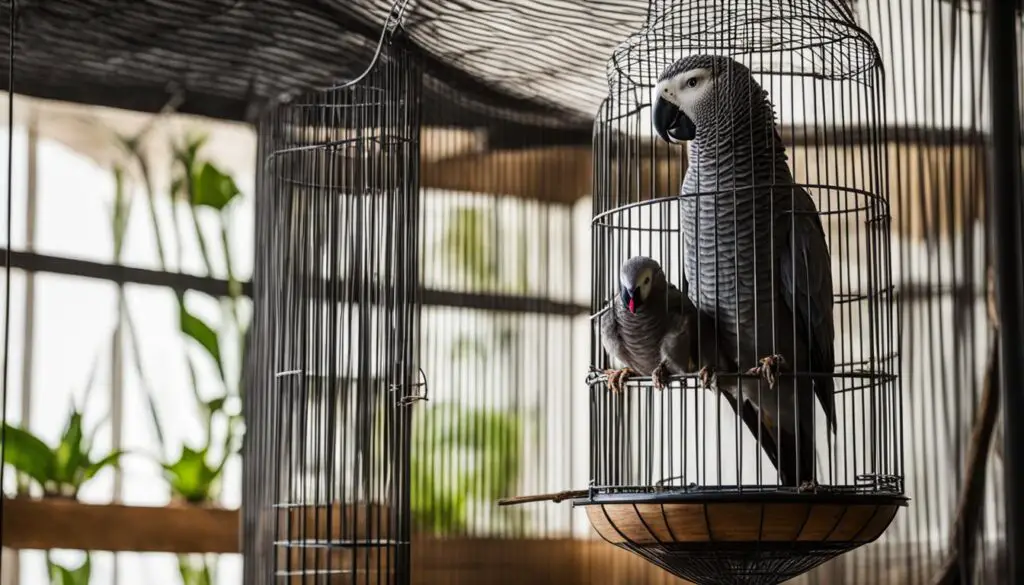
By creating a safe environment and offering enrichment activities, you can help satisfy your African Grey’s instinctual needs and reduce the likelihood of biting behavior.
Understanding Fear Biting in Parrots
Fear biting is a common behavior in parrots, including African Grey parrots. When these birds feel threatened or scared, they often use their beaks as a defense mechanism. It’s important for bird owners to understand the difference between nipping and biting, as it can help you respond appropriately and address the behavior effectively.
Nipping is a gentle warning bite that parrots use to communicate their discomfort. It’s a milder form of biting that serves as a warning sign. On the other hand, biting is a more forceful and aggressive behavior that parrots resort to when they feel extremely threatened or scared.
To address fear biting in parrots, desensitization and counterconditioning techniques can be highly effective. These training methods involve gradually exposing the parrot to fear-inducing stimuli in a controlled and positive manner, helping them overcome their fear and reduce their tendency to bite.
“Desensitization and counterconditioning techniques can be highly effective in reducing fear biting behavior in parrots, including African Greys,” says Dr. Jane Williams, an avian behavior specialist. “By slowly exposing the bird to the fear-inducing stimuli and pairing it with positive experiences, we can help the parrot associate the trigger with something pleasant instead of feeling threatened.”
Desensitization and Counterconditioning Process:
Desensitization and counterconditioning require patience and consistent effort. The process involves the following steps:
- Identify the fear-inducing trigger: Pinpoint the specific object, sound, or situation that triggers fear biting in your parrot.
- Start at a distance: Begin by exposing your parrot to the trigger from a distance where it feels comfortable and relaxed.
- Pair the trigger with positive experiences: While gradually moving closer to the trigger, offer rewards, such as treats or praise, to create positive associations.
- Slowly decrease the distance: Over time, decrease the distance between the parrot and the trigger, continuing to reinforce positive experiences.
- Monitor your parrot’s body language: Pay close attention to your parrot’s body language and stop immediately if you notice signs of discomfort or stress.
By following these steps and working with your parrot consistently, you can help them overcome their fear and reduce fear biting. Remember, every parrot responds differently, so it’s important to be patient and adapt the process to suit your bird’s needs.
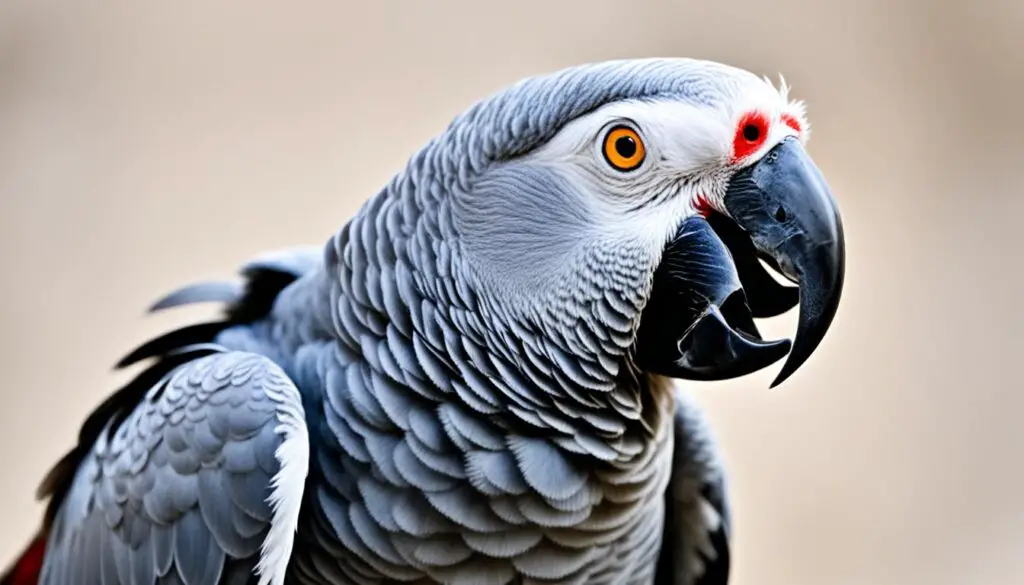
Creating a safe and nurturing environment for your African Grey parrot is essential in preventing fear biting. By addressing their fears through desensitization and counterconditioning, you can foster trust and build a strong bond with your feathered friend.
Managing Hormonal Biting in African Greys
Hormonal biting is a common issue in African Greys, especially during breeding season. This behavior is often a result of hormonal changes and the need for attention. To effectively manage hormonal biting in your African Grey, it is important to establish a consistent and positive reinforcement-based training approach.
“Positive reinforcement techniques can help redirect your parrot’s behavior and discourage biting.”
Positive reinforcement involves rewarding desired behaviors while redirecting or ignoring unwanted behaviors. This approach not only helps address hormonal biting but also strengthens the bond between you and your bird.
An avian behaviorist or experienced bird trainer can provide valuable guidance in dealing with hormonal biting. Their expertise and knowledge can help you develop a customized training plan for your African Grey, taking into account their specific needs and behavior patterns.
Remember, hormonal biting is a natural behavior for parrots and is influenced by their reproductive hormones. While it can be challenging to manage, with patience, consistency, and the right training techniques, you can help your African Grey overcome this behavior.
Key Strategies to Manage Hormonal Biting
| Strategy | Description |
|---|---|
| Providing Adequate Attention | Afford your African Grey plenty of social interaction and mental stimulation to help redirect their attention away from hormonal biting. |
| Manipulating Environmental Factors | Adjust the lighting, temperature, and overall environment to minimize hormonal triggers that may contribute to biting behavior. |
| Offering Alternative Chewing Options | Provide a variety of safe and engaging chew toys to redirect your parrot’s biting instincts towards appropriate objects. |
| Establishing Clear Boundaries | Teach your African Grey what is acceptable and what is not through consistent training, reinforcing desired behaviors, and redirecting biting tendencies. |
Remember to consult with a professional avian behaviorist or bird trainer for tailored advice and support in managing hormonal biting in your African Grey. Their expertise and guidance can help you navigate this behavior and maintain a harmonious relationship with your feathered friend.
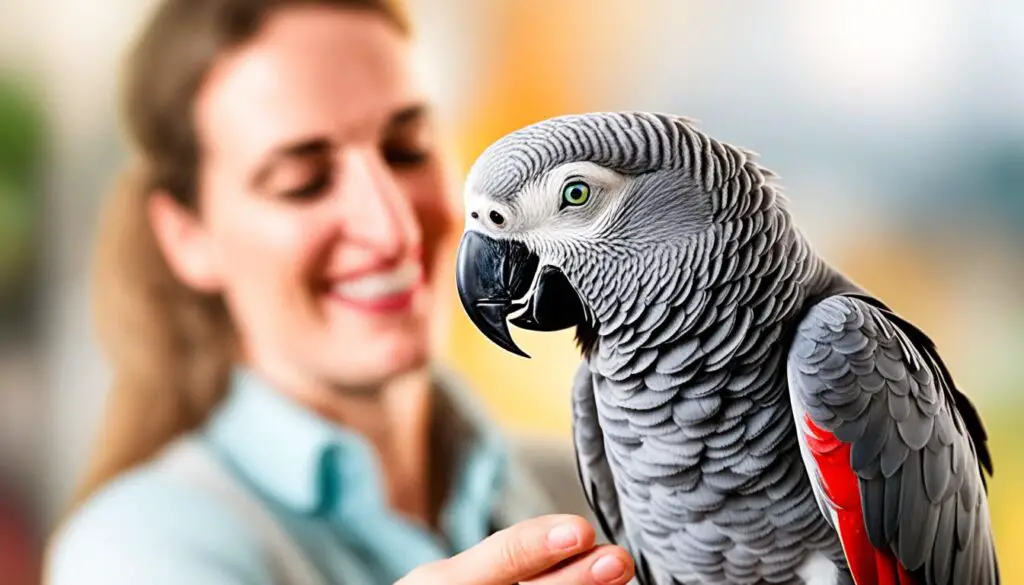
Prevention Tips for Biting Behavior
Preventing biting behavior in African Greys is essential for maintaining a harmonious relationship with your parrot. By implementing a few key strategies, you can minimize the risk of bites and create a safe and enjoyable environment for your feathered friend.
Respecting Boundaries
Respecting your parrot’s boundaries is crucial in preventing biting incidents. Be mindful of sudden movements or loud noises, as they can startle your African Grey and trigger a defensive response. Avoid invading your bird’s personal space when it shows signs of discomfort or aggression.
“Understanding and respecting your parrot’s body language cues can go a long way in reducing the likelihood of biting.”
Providing Interactive Toys
Interactive toys are excellent tools for keeping your African Grey mentally stimulated and engaged. Offer a variety of toys that encourage exploration, problem-solving, and play. Puzzle toys and foraging toys are particularly beneficial, as they provide your parrot with mental challenges and foraging opportunities.
“Interactive toys not only prevent boredom but also redirect your parrot’s focus from potential biting triggers to more constructive activities.”

Encouraging Foraging Opportunities
African Greys are intelligent and curious birds that thrive on mental stimulation. Providing foraging opportunities allows your parrot to engage in natural behaviors while keeping boredom at bay. Hide treats or favorite foods in various locations around the cage or create DIY foraging toys to keep your parrot entertained and mentally stimulated.
“Foraging opportunities mimic a bird’s natural habitat and encourage exploration, reducing the likelihood of biting due to boredom or frustration.”
Maintaining a Healthy Diet
A well-balanced and nutritious diet plays a vital role in your African Grey’s overall well-being and behavior. Consult with an avian veterinarian to determine the appropriate diet for your parrot’s specific needs. Providing a healthy and varied diet enriched with fresh fruits, vegetables, nuts, and high-quality pellets can promote good physical and mental health, which may help reduce biting tendencies.
Regular Vet Checkups
Regular veterinary checkups are essential for monitoring your African Grey’s health and preventing any underlying medical conditions that may contribute to biting behavior. Consult with an avian veterinarian for routine checkups, vaccinations, wing trims, and to address any concerns or unusual behavior patterns.
| Prevention Tips for Biting Behavior |
|---|
| Respecting Boundaries |
| Providing Interactive Toys |
| Encouraging Foraging Opportunities |
| Maintaining a Healthy Diet |
| Regular Vet Checkups |
Gentle Handling and Socialization
Gentle handling and socialization are essential aspects of creating a positive relationship with your African Grey parrot. By handling your bird with care and respect, you promote trust and reduce the likelihood of biting behaviors.
When interacting with your African Grey, remember to approach them in a calm and gentle manner. Avoid making sudden movements or loud noises that may startle or stress your bird. By maintaining a soothing environment, you can help your parrot feel secure and at ease.
Moreover, socialization plays a crucial role in shaping your African Grey’s behavior. Exposing your parrot to a variety of people, including family members, friends, and visitors, can help them feel comfortable and confident in different social situations. Positive experiences with various individuals can alleviate anxiety and promote social skills development.
Positive communication is also key in fostering a strong bond with your African Grey. Use reassuring and encouraging words to convey love and support to your feathered friend. This positive reinforcement not only strengthens your connection but also helps prevent biting behaviors.
Building trust and a sense of security through gentle handling and socialization empowers your African Grey to exhibit positive behavior traits and reduces the chances of developing aggressive tendencies. By investing time and effort in these areas, you create a harmonious environment for both you and your parrot.
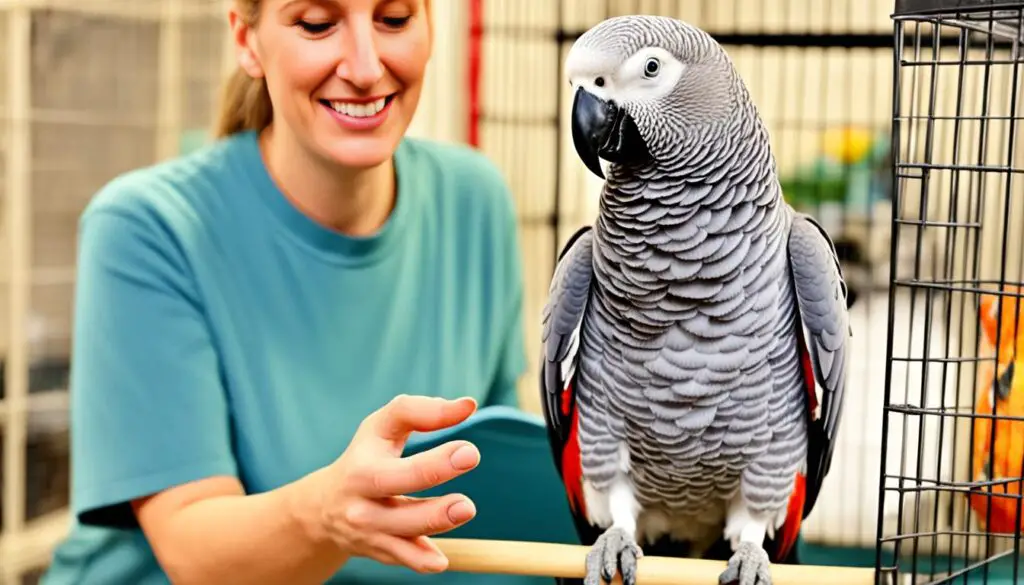
Expert’s Insight:
“Gentle handling and socialization are fundamental in preventing biting behaviors in African Grey parrots. By establishing trust through respectful interaction and exposing your parrot to different individuals, you provide a foundation for positive communication and behavior.” – Dr. Jane Peterson, Avian Behavior Specialist
Long-Term Commitment to Bird Ownership
Owning an African Grey or any parrot requires a long-term commitment. Your bird’s well-being and happiness depend on you as a responsible bird owner. By building a strong bond with your African Grey, you can prevent biting behavior and foster a loving and trusting relationship.
To ensure a fulfilling life with your African Grey, it is important to provide proper care, mental stimulation, and a safe environment. Educating yourself on parrot behavior and seeking professional help when needed will help you navigate the challenges of bird ownership.
Building a bond with your African Grey requires time, patience, and consistent positive interactions. Spend quality time with your bird, engaging in activities they enjoy, such as playing with toys or teaching them new tricks. Show them love and affection, and always respect their boundaries.
Creating a safe environment is essential for your bird’s well-being. Make sure their cage is spacious, clean, and filled with engaging toys and perches. Provide a balanced and nutritious diet, as recommended by an avian veterinarian, and schedule regular check-ups to monitor their health.
Enjoying Life with Your African Grey
One of the joys of owning an African Grey is the opportunity to enjoy a fulfilling life together. These intelligent and charismatic birds can provide great companionship and entertainment. Invest time in training sessions and teach your parrot new tricks using positive reinforcement techniques like clicker training or target training.
Take your African Grey on supervised adventures outside their cage, allowing them to explore and interact with their surroundings. This can include setting up a bird-safe play area or taking them for short flights in a controlled environment.
Share mealtime with your parrot, allowing them to join you at the table for bird-friendly foods. This provides not only a bonding opportunity but also mental stimulation and a chance for them to experience new tastes and textures.
Remember to capture and cherish precious moments with your African Grey through photography or videos. These memories will become mementos of your loving relationship and the joy that your bird brings to your life.

Embrace the responsibility of bird ownership, and enjoy the lifelong companionship and unique bond that you can build with your African Grey. With dedication, patience, and love, you can create a harmonious and fulfilling life together, free from the challenges of biting behavior.
Training Techniques for Biting Prevention
When it comes to preventing biting behavior in your African Grey parrot, training using positive reinforcement techniques can be highly effective. By using methods such as clicker training and target training, you can teach your parrot desirable behaviors while building a strong bond based on trust and mutual understanding.
Clicker training involves using a small handheld clicker device to mark and reinforce desirable behaviors. By associating the sound of the clicker with a reward, such as a treat or praise, you can communicate to your parrot that they have performed the desired behavior correctly. This technique helps your African Grey understand what is expected of them and encourages them to repeat the behavior in the future.
Target training, on the other hand, involves using a targeting stick or your hand as a target for your parrot to touch or follow. By rewarding your parrot each time they touch the target, you can guide them to perform specific actions or behaviors. Target training is a versatile technique that can be used to teach your African Grey a wide range of actions, from step-up commands to playful tricks.
Patience and consistency are crucial when training your parrot. Remember that birds, including African Greys, learn at their own pace. It may take time for your parrot to understand and master the desired behaviors. Be patient with their progress and offer plenty of positive reinforcement, such as treats and praise, when they demonstrate the correct behavior.
To further shape your African Grey’s behavior and reduce the likelihood of biting, it’s important to redirect unwanted behavior and reward good behavior. Whenever your parrot displays behavior you want to discourage, calmly and gently redirect their attention to a more appropriate activity or behavior. When your parrot behaves well, be sure to acknowledge and reward them with praise, treats, or playtime.
Remember, training is an ongoing process. Consistency is key in reinforcing positive behaviors and maintaining the bond you have built. By consistently using positive reinforcement techniques and providing clear guidance, you can effectively prevent biting behavior in your African Grey parrot.
Tip: When teaching new behaviors or commands, break them down into small steps and gradually increase the difficulty. This allows your parrot to understand and succeed at each step, building confidence and reinforcing the learning process.
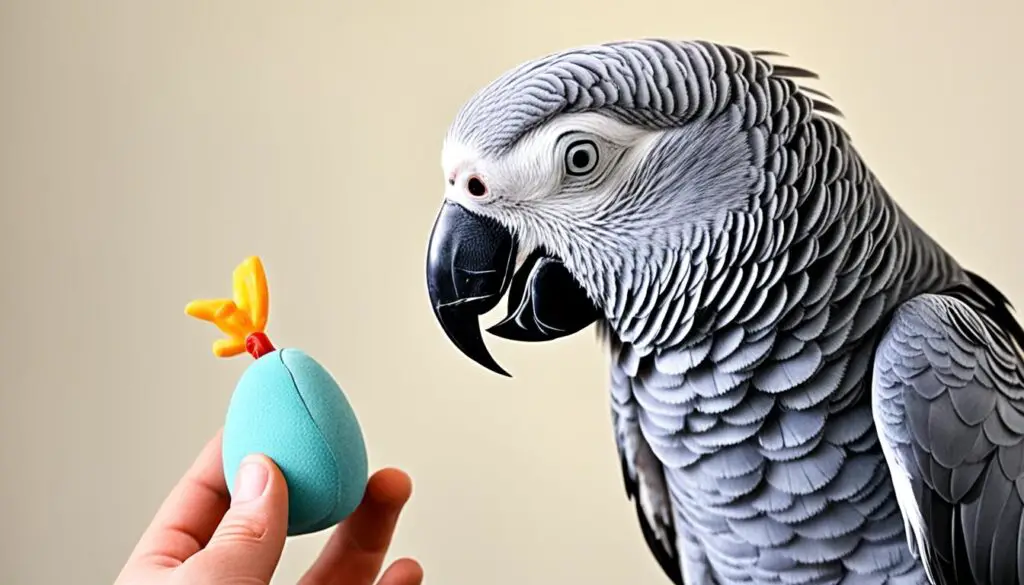
| Training Techniques | Description |
|---|---|
| Clicker Training | A method that uses a clicker device to mark and reinforce desirable behaviors. |
| Target Training | Using a target stick or hand as a target for your parrot to touch or follow, rewarding them for doing so. |
| Patience and Consistency | Being patient with your parrot’s learning process and consistently reinforcing positive behaviors. |
| Redirecting and Rewarding | Redirecting unwanted behavior to more appropriate activities and rewarding good behavior with treats, praise, or playtime. |
Creating a Safe and Enriching Environment
Creating a safe and enriching environment for your African Grey is essential to prevent biting behavior. By providing interactive toys, foraging opportunities, a healthy diet, and regular vet checkups, you can ensure your parrot’s overall well-being and reduce the likelihood of biting.
Interactive toys play a vital role in keeping your African Grey mentally stimulated and preventing boredom. These toys engage your parrot’s natural curiosity and provide entertainment. Choose toys that encourage problem-solving and offer a variety of textures and activities. Rotating toys regularly can help maintain your parrot’s interest.
Foraging opportunities are another excellent way to keep your African Grey mentally engaged and prevent biting. Hide treats or small pieces of food in foraging toys, allowing your parrot to search, explore, and use their problem-solving skills. This not only provides mental stimulation but also mimics natural foraging behavior in the wild.
Ensuring a healthy diet is crucial for your African Grey’s overall well-being and behavior. Offer a balanced diet that includes a variety of fresh fruits, vegetables, high-quality pellets, and occasional treats. Consult with a vet or avian nutritionist to determine the specific dietary needs of your parrot. Remember to provide fresh water daily to keep your African Grey hydrated.
Regular vet checkups are essential for maintaining your African Grey’s health and preventing potential underlying issues that may contribute to biting behavior. Schedule annual wellness exams, and consult your vet immediately if you notice any changes in your parrot’s behavior, appetite, or physical condition. Detecting and addressing health issues early can help prevent and manage biting.
Creating a safe and enriching environment for your African Grey is a key factor in preventing biting behavior. By incorporating interactive toys, foraging opportunities, maintaining a healthy diet, and scheduling regular vet checkups, you can promote your parrot’s overall well-being and reduce the likelihood of biting.
Recommended Interactive Toys and Foraging Options
| Interactive Toys | Description |
|---|---|
| 1. Puzzle toys | Require problem-solving skills to access hidden treats or rewards. |
| 2. Foraging boxes | Provide opportunities for your parrot to search for food or toys within hidden compartments. |
| 3. Shreddable toys | Offer your African Grey the chance to tear and shred items, mimicking natural behavior. |
| Foraging Opportunities | Description |
|---|---|
| 1. Foraging balls | Allow your parrot to roll and manipulate the ball to retrieve hidden treats. |
| 2. Foraging wheels | Present your African Grey with various challenges to access food rewards. |
| 3. Foraging mats | Let your parrot explore and search for food in a textured mat or surface. |
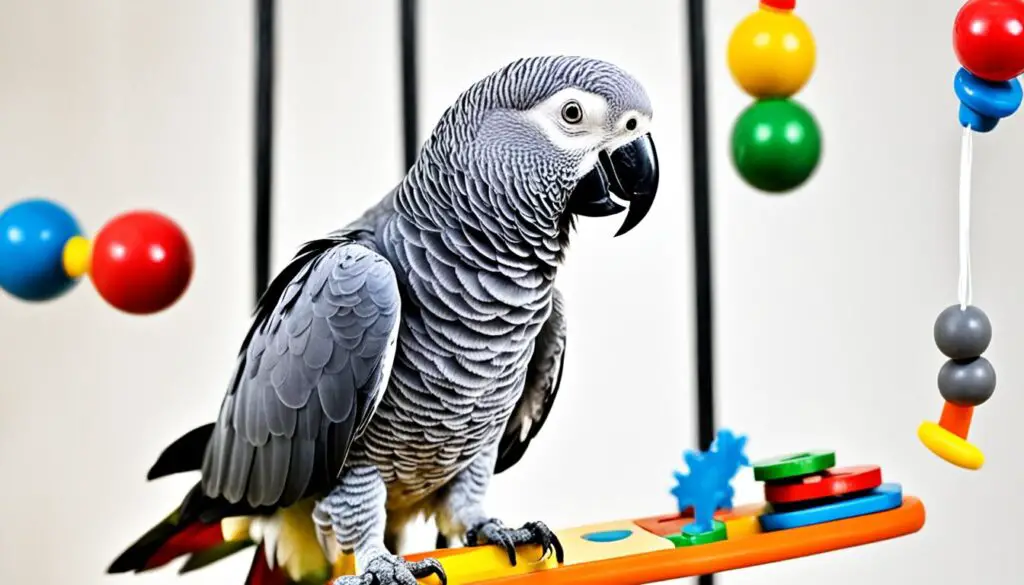
“A stimulating environment with interactive toys and foraging opportunities promotes mental well-being in African Greys.” – Avian Expert
Conclusion
Biting behavior in African Greys can be a challenging issue to deal with, but with patience, understanding, and the right approach, it can be effectively managed. By addressing the root causes of biting and creating a safe and enriching environment for your African Grey, you can build a strong bond and enjoy a fulfilling life together.
Remember, preventing biting requires a long-term commitment and consistent efforts. Take the time to understand your parrot’s body language cues and provide mental stimulation and enrichment activities to prevent boredom and overstimulation. Using positive reinforcement techniques and seeking professional help when needed can also greatly contribute to managing biting behaviors.
By implementing these strategies and investing in your parrot’s well-being, you can create a harmonious and enjoyable relationship with your African Grey. Embrace the journey of nurturing and enjoying life with your African Grey, and cherish the unique bond you share with your feathered companion.
FAQ
Why does my African Grey parrot bite?
African Grey parrots can bite for various reasons, including fear, frustration, territorial behavior, and over-bonding. Understanding your parrot’s body language cues and the reasons behind their biting behavior is essential in preventing it.
How can I prevent my African Grey from biting?
To prevent biting behavior in your African Grey, it is important to respect their boundaries, avoid sudden movements or loud noises, and provide interactive toys and foraging opportunities for mental stimulation. Building trust and establishing clear boundaries can also help reduce the risk of biting.
How can I address fear biting in my parrot?
Fear biting in parrots can be addressed through desensitization and counterconditioning techniques. Gradually exposing your parrot to fear-inducing stimuli in a positive and controlled manner can help reduce the fear-based biting behavior.
How can I manage hormonal biting in my African Grey?
Hormonal biting in African Greys is common, especially during breeding season. Providing a consistent and positive reinforcement-based training approach can help manage hormonal biting. Consulting an avian behaviorist or experienced bird trainer can provide valuable guidance in dealing with this problem.
What steps can I take to prevent biting behavior in my African Grey?
To prevent biting behavior in your African Grey, it is important to respect your parrot’s boundaries, avoid sudden movements or loud noises, provide interactive toys and foraging opportunities, and maintain a healthy diet and regular vet checkups. Ensuring a safe and enriching environment for your parrot can help reduce the likelihood of biting.
How can I handle my African Grey gently and promote positive socialization?
Gentle handling and socialization are crucial for creating a positive relationship with your African Grey. Handling your bird with care and respect, socializing them with a variety of people, and using positive communication can help your parrot feel comfortable and secure in different situations.
What long-term commitment is required for African Grey ownership?
Owning an African Grey or any parrot requires a long-term commitment. Building a strong bond, maintaining positive interactions, and providing proper care, mental stimulation, and a safe environment are vital in preventing biting behavior and ensuring the well-being and happiness of your parrot.
What training techniques can I use to prevent biting behavior in my African Grey?
Training your African Grey using positive reinforcement techniques such as clicker training and target training can be highly effective in preventing biting behavior. Patience and consistency are key when training your parrot, as it takes time for them to learn and understand the desired behaviors.
How can I create a safe and enriching environment for my African Grey?
Creating a safe and enriching environment for your African Grey involves providing a variety of interactive toys, foraging opportunities, a healthy diet, and regular vet checkups. Regular enrichment activities and mental stimulation can help reduce the likelihood of biting behavior.
How can I enjoy life with my African Grey?
By addressing the root causes of biting, creating a safe and enriching environment, using positive reinforcement training techniques, and building a strong bond with your African Grey, you can enjoy a fulfilling life together. Preventing biting is a long-term commitment that requires consistency and ongoing efforts to ensure the well-being and happiness of your parrot.
Source Links
- https://exoticdirect.co.uk/news/biting-and-feather-plucking-parrots/
- https://birdsupplies.com/pages/5-tips-on-how-to-stop-a-biting-parrot
- http://trainedparrot.com/Stop_Biting/

My name is Shane Warren, the author behind Your Bird Buddy – your ultimate guide to the wonderful world of birds! Unleash your inner avian explorer as we delve into a vibrant library of knowledge dedicated to all things feathered. From learning about diverse bird species from across the globe to understanding their captivating habitats and behaviors, I’m here to fuel your passion for these magnificent creatures. Not only that, but I also provide valuable insights on being a responsible and informed pet bird owner. Join our vibrant community and let’s celebrate the feathered wonders of the world together – one chirp at a time. And be sure to join our Your Bird Buddy Community over on Facebook!

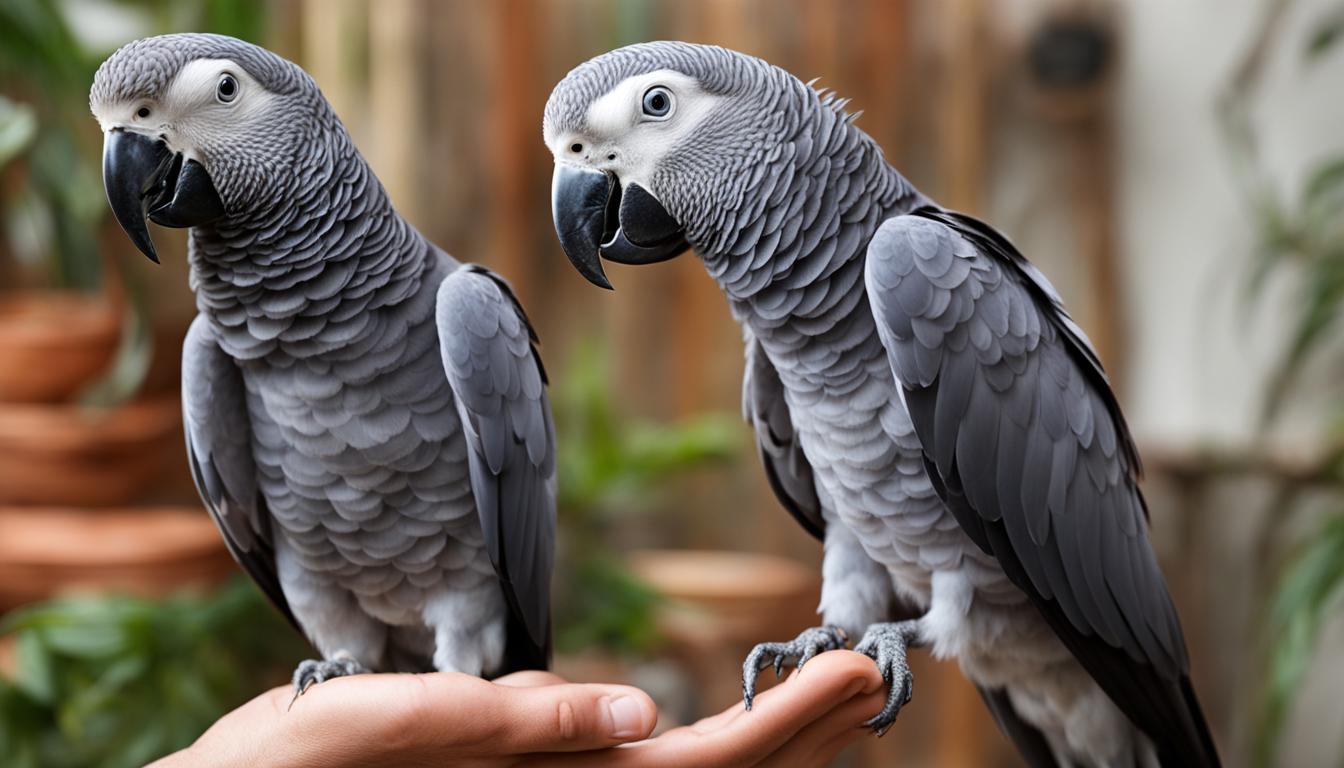
Comments are closed